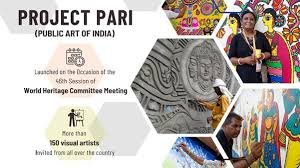Ministry of Culture Initiates Project PARI for the 46th World Heritage Committee Meeting
Introduction
The Ministry of Culture has recently launched Project PARI (Protecting Archaeological Remains and Integrities) to prepare for the 46th World Heritage Committee meeting. This significant initiative underscores India’s commitment to preserving its rich cultural heritage and ensuring its historical sites are recognized globally.
Objective of Project PARI
The primary objective of Project PARI is to safeguard and maintain India’s archaeological remains and ensure they meet the standards set by UNESCO. This project aims to enhance the preservation techniques and management practices of the country’s historical sites, ensuring their longevity and international recognition.
Scope and Implementation
Project PARI encompasses various activities, including the documentation, conservation, and promotion of heritage sites. The Ministry of Culture will collaborate with state governments, local authorities, and international experts to implement this project. Advanced technologies like 3D scanning and GIS mapping will be employed to create detailed records of the sites.
Expected Outcomes
The implementation of Project PARI is expected to yield significant outcomes. It will not only protect India’s invaluable cultural assets but also boost tourism by promoting these sites internationally. Moreover, it will enhance India’s reputation in the global arena as a nation committed to preserving its cultural heritage.
Challenges and Solutions
Preserving archaeological remains comes with its set of challenges, including environmental degradation, urbanization, and lack of awareness. Project PARI aims to address these challenges through community involvement, educational programs, and stricter regulations to prevent unauthorized constructions near heritage sites.
Conclusion
Project PARI is a commendable initiative by the Ministry of Culture, reflecting India’s dedication to preserving its rich cultural heritage. As the 46th World Heritage Committee meeting approaches, this project will play a crucial role in showcasing India’s historical treasures on the global stage.
Why This News is Important
Highlighting India’s Cultural Commitment
The launch of Project PARI highlights India’s dedication to preserving its cultural heritage. This is particularly important as the country prepares to host the 46th World Heritage Committee meeting, showcasing its rich history and efforts in cultural preservation.
Boosting Tourism
By protecting and promoting its heritage sites, India can attract more tourists, contributing significantly to the economy. The international recognition of these sites will enhance their appeal, drawing visitors from around the world.
Strengthening Global Reputation
India’s proactive measures in preserving its heritage through Project PARI will strengthen its reputation in the international community. It reflects a commitment to global standards of conservation and cultural management.
Educational Impact
Project PARI also serves an educational purpose, raising awareness about the importance of preserving cultural heritage among the younger generation. This can foster a sense of pride and responsibility towards the nation’s historical assets.
Addressing Preservation Challenges
The project addresses the critical challenges faced in heritage preservation, including environmental threats and urbanization. By implementing advanced technologies and community involvement, Project PARI provides sustainable solutions to these issues.
Historical Context
Background of the World Heritage Committee
The World Heritage Committee, established under the UNESCO World Heritage Convention, is responsible for identifying and preserving sites of outstanding cultural or natural importance. India has been an active participant in this committee, with several of its sites listed as World Heritage Sites.
India’s Heritage Preservation Efforts
India has a long history of cultural preservation, with various initiatives and laws in place to protect its heritage. The Archaeological Survey of India (ASI), established in 1861, plays a pivotal role in the conservation of historical sites across the country.
Previous Initiatives
Prior to Project PARI, India has launched several initiatives to preserve its heritage. Projects like Adopt a Heritage and the National Mission on Monuments and Antiquities are notable examples of the country’s ongoing efforts in this domain.
Key Takeaways from Project PARI for the 46th World Heritage Committee Meeting
| Serial Number | Key Takeaway |
|---|---|
| 1 | Project PARI aims to protect India’s archaeological remains and heritage sites. |
| 2 | The project involves documentation, conservation, and promotion of heritage sites. |
| 3 | Advanced technologies like 3D scanning and GIS mapping will be used. |
| 4 | Project PARI will enhance tourism and India’s global reputation in cultural preservation. |
| 5 | The initiative addresses challenges such as environmental threats and urbanization through community involvement and educational programs. |
Important FAQs for Students from this News
1. What is Project PARI?
Project PARI (Protecting Archaeological Remains and Integrities) is an initiative by the Ministry of Culture aimed at safeguarding and preserving India’s archaeological sites in preparation for the 46th World Heritage Committee meeting.
2. Why is Project PARI important?
Project PARI is crucial for preserving India’s cultural heritage and ensuring international recognition of its historical sites. It also aims to boost tourism and strengthen India’s global reputation in cultural conservation.
3. How will Project PARI be implemented?
Project PARI will involve activities such as documentation, conservation, and promotion of heritage sites using advanced technologies like 3D scanning and GIS mapping. Collaboration with state governments and international experts is key to its implementation.
4. What are the expected outcomes of Project PARI?
The project is expected to protect archaeological remains, enhance tourism, and improve India’s standing in global cultural preservation efforts. It also aims to address challenges like environmental degradation and urbanization near heritage sites.
5. What are the challenges faced by Project PARI?
Project PARI faces challenges such as environmental threats, urbanization, and the need for community involvement. Educational programs and stricter regulations are planned to mitigate these challenges.

